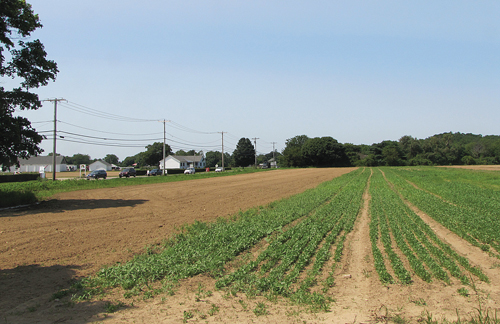46-lot subdivision on Sound Ave meets opposition from neighbors

A plan to convert a 27-acre Sound Avenue farm into a 46-home subdivision was met with resistance last week from neighbors who said the parcel should be preserved as farmland.
After settling an 8-year-old lawsuit, Gendot Associates has proposed doubling the density regularly allowed at the site, located at the northwest corner of Roanoke and Sound avenues, through the town’s transfer of development rights program. That option enables developers to purchase building rights off farmland and move them to certain areas the town has determined additional development is warranted.
Members of the Roanoke Landing Civic Association — which, according to representative John Andes represents about 95 houses — opposed the application at last week’s public hearing in front of the Planning Board.
“What attracted us to the area 20 years ago was the fact that it was a vibrant farming community,” said John McAuliff, who added that the subdivision would contribute to the “commercialization of Sound Avenue.”
Under current zoning, the 27 acres Gendot Associates is purchasing allows for just 23 lots, but developers purchased an additional 23, bringing the total to 46. Their plans also show a clubhouse, pool and patio, three acres of farmland along Sound Avenue and a seven-acre “common area” farther north.
Their attorney, Charles Cuddy, said the plan dates back to 2004 and that it received preliminary Planning Board approval in 2005. However, it then became embroiled in litigation between the developer, Gendot, and the property owners, Edmund and Florence Kaufold, for eight years.
The lawsuit is now over, he said, and Gendot is in contract to purchase the property within the next few weeks.
“We think the map is appropriate and in accordance with town code,” Mr. Cuddy said. “This is one of the few viable receiving areas [for TDR credits] that exist, that can have this done in this fashion. And that’s what TDRs are all about,” he said.
He said few development rights transfers have been used for residential development under that program, which aims to preserve farms.
But Planning Board member Joe Baier, a former county health department official, said the 10,000-square-foot lots called for in the plan are too small, even for a “double density” TDR project.
“I don’t think we should seek 10,000-square-foot lots,” he said. “I’d like to see more options and, certainly, larger lots.”
Mr. Cuddy said the lots are small in order to preserve some remaining farmland that fronts Sound Avenue. Zoning code allows the 10,000-square-foot lots, he added.
“We don’t like the high density that’s in the plan, and our ideal goal would be to keep it as farmland and have the development rights sold,” Mr. Andes said.
Resident Sherry Patterson, who said the land has been farmed for as long as she can remember, said she’d like to see it remain that way.
Mr. Baier asked if there has been any interest from the town or county in preserving the land as farmland.
“I think the county would be interested in the prime soils that exist there,” town planning director Rick Hanley said.
Mr. Baier said he doesn’t support the current plan and suggested eliminating the seven-acre common area in order to make the lots bigger — an option Mr. Cuddy said could be considered.
Mr. Cuddy asked that the hearing be kept open so he can discuss potential changes to the plan with his client, something the board agreed to.







